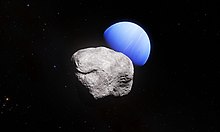海卫十四
 | |
| 发现 | |
|---|---|
| 发现者 | 马克·肖沃尔特、I. de Pater、杰克·利绍尔、R. S. French[1] |
| 发现日期 | July 1, 2013年7月1日 |
| 编号 | |
| 命名依据 | 马头鱼尾怪 |
| 其它名称 | S/2004 N 1 |
| 轨道参数[4] | |
| 半长轴 | 105,284 km |
| 离心率 | 0.00048±0.00032 |
| 轨道周期 | 0.9362 d[2] |
| 平均轨道速度 | 8.9408 km/s[3] |
| 轨道倾角 | |
| 隶属天体 | 海王星 |
| 物理特征 | |
| 平均半径 | 17.4±2.0 km[4] |
| 质量 | ≈5×1016 kg[6] |
| 自转周期 | synchronous |
| 转轴倾角 | 零 |
| 反照率 | 假设很低(≈0.09[4]) |
| 视星等 | 26.5[2] |
希波坎普(Hippocamp)最初被称为S/2004 N 1,是海王星的一颗小卫星,直径大约仅有35 km(20 mi),它的轨道周期短于一天。这颗卫星的发现于2013年7月1日公诸于世,并使海王星的卫星数量增加为14颗[7]。这颗卫星因为过于黯淡,因此旅行者2号在1989年探测海王星时未能发现它。SETI协会的马克·肖沃尔特经由分析哈勃空间望远镜在2004年至2009年拍摄的海王星照片找到它[8]。
2018年9月25日,在小行星通告111804上正式公告为海卫14,2019年2月命名为希波坎普(Hippocamp)。
发现
马克·肖华特在2013年7月1日检视哈勃空间望远镜于2009年拍摄的亚当斯环弧的影像时发现了希波坎普。他使用一种类似水平摇摄的技术来补偿轨道运动,并且透过多个模糊影像的叠加来产生细节[7][9][10]。在决定扩展搜寻范围,"随心所欲"的超出环的半径后[11],他发现相当明显可以代表新卫星的光点[2]。然后,他不断地在哈勃空间望远镜在2004年之后拍摄的影像中发现相同的光点。旅行者2号曾经观测到海王星所有的内侧卫星,但由于它非常昏暗,所以在1989年时没有观测到[7]。鉴于相关的图像早已向大众公开,因此,任何人都可以进行此一发现[2]。
起源
海王星最大的卫星崔顿是一颗轨道逆行,且大角度倾斜的卫星。据推测,崔顿是在原始的海王星系统形成后,才被从柯伊伯带捕获。先前存在的卫星会因为此一事件而改变轨道,导致一些卫星弹射出去或和其它的卫星碰撞而被破坏[13][14]。 至少,现在存在的海王星内侧卫星是在崔顿的轨道受到潮汐减速之后,从碎石的废墟中吸积形成的[15]。
另一个假设认为,希波坎普可能是从最靠近海王星的大卫星,普罗杜斯(海卫八)受到撞击产生的碎屑形成的[6][4]。碎屑可能是由彗星撞击的最大陨石坑法罗斯撞击坑喷出的;由这个撞击坑喷出的物质,体积大约是希波坎普的50倍。希波坎普的轨道相对地靠近普罗杜斯,它们的半长轴相差约12,000公里。希波坎普可能在距离普罗杜斯只有数千公里之内形成,然后由于它与海王星相互的潮汐作用更为强烈,才与普罗杜斯拉开了距离[4]。
物理性质

一般认为希波坎普的表面类似其它的内侧卫星一样,像"肮脏的沥青"一样黑 [9]。它们的几何反照率范围在0.07至0.10之间 [17]。最初,依据希波坎普26.5的视星等估计,它的直径在16至20公里,使它成为海王星最小的卫星。最近对海王星卫星的观测显示,希波坎普的直径为34.8公里,几乎是先前估计的两倍[4]。然而,它依然是海王星内侧,常规卫星中最小的。
使用哈勃空间望远镜的近红外线照相机和多目标分光仪(NICMOS)检查了海王星环和内侧卫星的近红外光谱[18][19],类似太阳系小天体黑暗、红化物质的特征,似乎存在于其所有的表面。资料显示含有有机化合物碳-氢键(C-H键)、和/或碳-氮键(C≡N)的结合[19],但光谱的分辨率不足以识别是何种分子。认为存在外太阳系富含的水冰,但是在光谱中无法观察到其特征(不像天王星的小卫星)[19]。
轨道属性

希波坎普每22小时28.1分钟(0.9362天)公转海王星一圈[2],暗示它的轨道半长轴,或轨道距离约为105,283 km(65,420 mi),正好略高于地月距离的四分之一,或大约是海王星环平均半径的两倍。它的轨道倾角和离心率都接近零[2],并介于拉里萨和普罗杜斯之间,成为海王星外层规则卫星的第二颗。这种卫星的趋势是直径随者与主体行星的距离增加而增加,但它却反其道而行,是在这个位置上最小的卫星[5]。
拉里萨和西坡坎普的周期有着3:5的轨道共振,差异只有1%左右;而希波坎普和普罗杜斯的周期有差异少于0.1%以内的5:6共振[Note 1]。一般认为拉里萨和普罗杜斯在几亿年前可能经历了1:2的平均运动共振[20][21]。普罗杜斯[20]和希波坎普因为在海王星的同步轨道之外(海王星的自转周期为0.6713天[22]),所以一直在远离拉里萨,并因此被潮汐加速,而拉里萨在其内,则受到潮汐减速[20]。
命名
这颗卫星以希腊神话中的生物,马头鱼尾怪(Hippocamp)命名为希波坎普[23]。这颗卫星在2013年编号为海卫十四,但直到2019年2月才获得正式的名字。
发现小组决定依据古希腊罗马神话中与海神波塞冬或尼普顿有关的一张图中,向国际天文学联合会提交[11]与海王星其它卫星一致的名称[24]。 考虑的名称包括波塞冬独眼的大儿子波利菲莫斯(Polyphemus)和托俄萨(Thoosa)[25]。团队的领导人,肖华特选择了西坡坎普这个名字,部分原因是认同"海马属"的海马恰如其分的有着马头鱼尾[3]。在2019年,国际天文学联合会接受了希波坎普的名字[26]。
注解
- ^ 这三颗卫星的轨道周期各自为0.55465、0.93618和1.12231天,实际的比率值为2.962:5.000:5.994
参考资料
- ^ Yeomans, D. K.; Chamberlin, A. B. Planetary Satellite Discovery Circumstances. JPL Solar System Dynamics web site. Jet Propulsion Lab. 2013-07-15 [2013-07-17]. (原始内容存档于2009-08-14).
- ^ 2.0 2.1 2.2 2.3 2.4 2.5 Kelly Beatty. Neptune's Newest Moon. Sky & Telescope. 15 July 2013 [12 June 2017]. (原始内容存档于2013-07-16).
- ^ 3.0 3.1 Ian Sample. 'Breakneck speed' mini moon hurtles around Neptune at 20,000mph. The Guardian. 2019-02-20 [2019-02-20]. (原始内容存档于2021-01-13).
- ^ 4.0 4.1 4.2 4.3 4.4 4.5 4.6 Showalter, M. R.; de Pater, I.; Lissauer, J. J.; French, R. S. The seventh inner moon of Neptune. Nature. 2019, 566 (7744): 350–353. doi:10.1038/s41586-019-0909-9.
- ^ 5.0 5.1 Editors of Sky & Telescope. A Guide to Planetary Satellites. Sky & Telescope web site. Sky & Telescope. [2013-07-17]. (原始内容存档于2013-10-16).
- ^ 6.0 6.1 Karl Hille. Tiny Neptune Moon Spotted by Hubble May Have Broken from Larger Moon. NASA. 2019-02-20 [2019-02-20]. (原始内容存档于2019-02-21).
- ^ 7.0 7.1 7.2 Hubble Finds New Neptune Moon. Space Telescope Science Institute. 2013-07-15 [2013-07-15]. (原始内容存档于2014-02-21).
- ^ Nasa's Hubble telescope discovers new Neptune moon. BBC News. 2013-07-15 [2013-07-16]. (原始内容存档于2019-04-04).
- ^ 9.0 9.1 Showalter, M. R. How to Photograph a Racehorse ...and how this relates to a tiny moon of Neptune. Mark Showalter's blog. 2013-07-15 [2013-07-16]. (原始内容存档于2013-07-18).
- ^ 10.0 10.1 Grossman, L. Neptune's strange new moon is first found in a decade. New Scientist space web site. New Scientist. 2013-07-15 [2013-07-18]. (原始内容存档于2013-09-02).
- ^ 11.0 11.1 Klotz, I. Astronomer finds new moon orbiting Neptune. Reuters. 2013-07-15 [2013-07-16]. (原始内容存档于2015-09-24).
- ^ Marsden, Brian G.; S/2002 N 4 (页面存档备份,存于互联网档案馆), MPEC 2003-S107 (30 September 2003)
- ^ Goldreich, P.; Murray, N.; Longaretti, P. Y.; Banfield, D. Neptune's story. Science. 1989, 245 (4917): 500–504. Bibcode:1989Sci...245..500G. PMID 17750259. doi:10.1126/science.245.4917.500.
- ^ Agnor, C. B.; Hamilton, D. P. Neptune's capture of its moon Triton in a binary–planet gravitational encounter. Nature. 2006-05-11, 441 (7090): 192–194. Bibcode:2006Natur.441..192A. PMID 16688170. doi:10.1038/nature04792.
- ^ Banfield, Don; Murray, Norm. A dynamical history of the inner Neptunian satellites. Icarus. October 1992, 99 (2): 390–401. Bibcode:1992Icar...99..390B. doi:10.1016/0019-1035(92)90155-Z.
- ^ Hubble helps uncover origin of Neptune’s smallest moon Hippocamp. www.spacetelescope.org. [21 February 2019]. (原始内容存档于2020-11-08) (英语).
- ^ Karkoschka, Erich. Sizes, shapes, and albedos of the inner satellites of Neptune. Icarus. 2003, 162 (2): 400–407. Bibcode:2003Icar..162..400K. doi:10.1016/S0019-1035(03)00002-2.
- ^ Dumas, C.; Terrile, R. J.; Smith, B. A.; Schneider, G. Astrometry and Near-Infrared Photometry of Neptune's Inner Satellites and Ring Arcs. The Astronomical Journal. March 2002, 123 (3): 1776–1783. Bibcode:2002AJ....123.1776D. ISSN 0004-6256. doi:10.1086/339022.
- ^ 19.0 19.1 19.2 Dumas, C.; Smith, B. A.; Terrile, R. J. Hubble Space Telescope NICMOS Multiband Photometry of Proteus and Puck. The Astronomical Journal. August 2003, 126 (2): 1080–1085. Bibcode:2003AJ....126.1080D. ISSN 0004-6256. doi:10.1086/375909.
- ^ 20.0 20.1 20.2 Zhang, K.; Hamilton, D. P. Orbital resonances in the inner neptunian system: I. The 2:1 Proteus–Larissa mean-motion resonance. Icarus. June 2007, 188 (2): 386–399. Bibcode:2007Icar..188..386Z. ISSN 0019-1035. doi:10.1016/j.icarus.2006.12.002.
- ^ Zhang, K.; Hamilton, D. P. Orbital resonances in the inner neptunian system: II. Resonant history of Proteus, Larissa, Galatea, and Despina. Icarus. January 2008, 193 (1): 267–282. Bibcode:2008Icar..193..267Z. ISSN 0019-1035. doi:10.1016/j.icarus.2007.08.024.
- ^ Williams, David R. Neptune Fact Sheet. NASA. 1 September 2004 [18 July 2013]. (原始内容存档于2011-08-17).
- ^ Timmer, John. Hubble images show a Neptune moon that may have been repeatedly reborn. Ars Technica. 20 February 2019 [21 February 2019]. (原始内容存档于2020-11-07) (美国英语).
- ^ Planet and Satellite Names and Discoverers. Gazetteer of Planetary Nomenclature. USGS Astrogeology. [2013-07-18]. (原始内容存档于2009-10-10).
- ^ Vincent, James. Astronomers throw open the doors to the public-naming of planets. The Independent. 16 August 2013 [16 August 2013]. (原始内容存档于2015-09-25).
- ^ Mortillaro , Nicole. Scientists reveal Neptune's tiny new moon, Hippocamp. CBC News. 20 February 2019 [20 February 2019]. (原始内容存档于2020-12-13).
外部链接
| ||||||||||||||||||||||||||||||||
| ||||||||||||||||||||||||||||||
| |||||||||||||||||||||||||||||||||||||||||||||||||||||||||||
Text is available under the CC BY-SA 4.0 license; additional terms may apply.
Images, videos and audio are available under their respective licenses.



